 Website:
NETZSCH Grinding & Dispersing
Website:
NETZSCH Grinding & Dispersing
Group: NETZSCH
Catalog excerpts

Proven Excellence. Process Technology for Ceramic Applications Push the boundaries... CHEMICAL INDUSTRY a Business Field of NETZSCH Grinding & Dispersing
Open the catalog to page 1
Ceramic applications have become indispensable in the modern world. They are used wherever conventional materials reach their limits. be it wear resistance. heat resistance. biocompatibility or even special electrical properties. Ceramic materials can always be selected specifically for the particular application. for example heat-resistant components in space travel or the inrun of a ski jump. Because of their versatility. ceramics are used more often than one would expect. Mixing and grinding down to the submicron range - as a laboratory machine. stand-alone machine or even as a complex...
Open the catalog to page 2
Whether at home or on the move. in the office or even in production. parts and components made of high-tech ceramics can be adapted to a wide variety of applications. Where other materials reach their limits. high-tech ceramics are employed. Hardness. wear resistance and temperature resistance are the properties that matter. But it is precisely these properties that demand top performance from our production machines. For this reason. the machines must always be specially adapted to the particular requirements as well. e.g.. purity. hardness or wear protection. Wet mills in this area are...
Open the catalog to page 4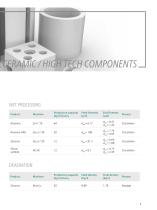
Product Alumina Alumina HPA Zirconia Silicon carbide Machine Zeta® 10 Discus® 30 Discus® 20 KE 50 Production capacity Feed fineness End fineness [kg/h] slurry [pm] [pm] Circulation Circulation Circulation Circulation DEAERATION Product Zirconia Machine MiniVac Production capacity Feed density Final density p [kg/h] slurry [kg/l] [kg/l] process
Open the catalog to page 5
Utility ceramics have been with us for thousands of years and are ubiquitous in our daily lives. Utility ceramics is the term used to describe any ceramic that has been created to support us in our everyday lives. Since these are mostly mass-produced goods, grinding units with a high throughput capacity are used. Starting materials for utility ceramics are mainly ground natural minerals. Coating compounds for protection or decoration, are a large area of application for the NETZSCH agitator bead mills, for example, the Discus® series. Product Machine Production capacity Feed fineness End...
Open the catalog to page 6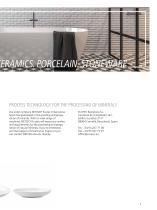
CERAMICS. PORCELAIN. STONEWARE PROCESS TECHNOLOGY FOR THE PROCESSING OF MINERALS Our sister company NETZSCH Ecutec in Barcelona Spain has specialized in the grinding and preparation of minerals. With its wide range of machines, NETZSCH Ecutec will meet your wishes and requirements for the processing and preparation of natural minerals. If you‘re interested, we‘ll be happy to forward your inquiry or you can contact NETZSCH Ecutec directly. ECUTEC Barcelona S.L. Carretera de l’Hospitalet 147, Edificio Londres 2º-1ª 08904 Cornellà, Barcelona | Spain Tel.: +34 93 247 77 00 Fax: +34 93 247 77 01...
Open the catalog to page 7
Whether for grinding. polishing or wear protection. only the hardest ceramics are used here. The most important representatives are oxides. nitrides and carbides. The correct choice of grinding process and grinding chamber lining are the decisive factors. For dry processing. the jet mill is particularly suitable. as the product particles grind each other. After grinding. our high-performance classifiers ensure separation into the various FEPA classifications. Since. in some cases. sufficiently wear-resistant grinding beads do not exist for wet mills. it is then necessary to switch to...
Open the catalog to page 8
WET PROCESSING Product Machine a-Alumina Zeta® 25 Boron nitride Zeta® 10 Production capacity Feed fineness End fineness [kg/h] slurry [pm] [pm] 11 7 30 13 38 7.5 2 Passages Circulation Autogenic grinding Circulation Autogenic grinding Circulation Autogenic grinding Circulation Circulation
Open the catalog to page 9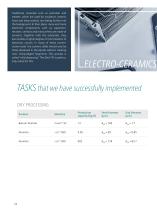
Traditional materials such as porcelain and steatite. which are used for insulators. ceramic fuses and lamp sockets. are fading further into the background. In their place. more and more electronic components such as capacitors. resistors. varistors and many others are made of ceramics. Together with the substrates. they also enable a higher degree of micronization of electronic circuits. In many of these comminution tasks. the ceramic solids should only be finely dispersed in the liquids without creating new. sharp-edged fragments. This process is called "mild dispersing". The Zeta® RS is...
Open the catalog to page 10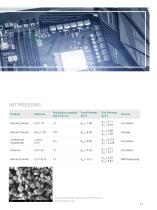
Production capacity Feed fineness End fineness Barium titanate Zeta® 10 Barium titanate Discus® 20 Lanthanum hexaboride LabStar Zeta® Barium titanate Zeta® RS 4 Circulation Passage Circulation Circulation Mild Dispersing
Open the catalog to page 11
In the case of catalysts, not only the carrier materials but also the active substances are finely ground. Because of their expensive active substances, these so-called washcoats must be processed with as little residue as possible. With a relatively small grinding chamber capacity and high power density, our high-performance mills such as the Neos series are ideally suited for this purpose.
Open the catalog to page 12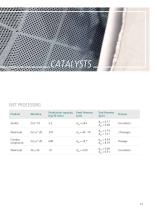
Product Zeolite Washcoat Catalyst compound Washcoat Machine Zeta® 10 Discus® 20 Discus® 20 Neos 20 Production capacity Feed fineness End fineness [kg/h] slurry [pm] [pm] Process Circulation 2 Passages Passage Circulation
Open the catalog to page 13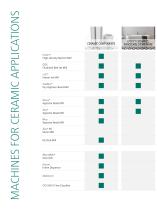
CERAMIC COMPONENTS UTILITY CERAMICS, PORCELAIN, STONEWARE ConJet® High-density Bed Jet Mill CGS Fluidized Bed Jet Mill s-Jet® Steam Jet Mill SpheRho® Dry Agitator Bead Mill Discus® Agitator Bead Mill Zeta® Agitator Bead Mill Neos Agitator Bead Mill Zeta® RS Nano Mill KE Disk Mill MasterMix® Dissolver Epsilon Inline Disperser CFS/HD-S Fine Classifier
Open the catalog to page 14
Classifying, Mixing & Deaeration ABRASIVES AND POLISHES, WEAR PROTECTION
Open the catalog to page 15
PRODUCTION MACHINES for Dry Grinding SpheRho®® Agitator Bead Mill The CGS fluidized bed jet mill with integrated classifier enables low-contamination fine grinding of dry products of any hardness. Due to the special grinding principle, product grinding is completely autogenous. The comminution energy is provided exclusively by gas jets, so that there is no wear on grinding tools. An optional ceramic lining is available for wear protection. The SpheRho®® dry agitator bead mill is fed con-tinuously via a rotary feeder. A shaft equipped with exchangeable agitator tools is mounted inside the...
Open the catalog to page 16All NETZSCH Grinding & Dispersing catalogs and technical brochures
-
NETZSCH MiniVac
2 Pages
-
NETZSCH ConduxVita
4 Pages
-
NETZSCH Pre-Grinding Mill ProPhi
12 Pages
-
NETZSCH Zumba
4 Pages
-
NETZSCH Image G&D
28 Pages
-
NETZSCH Connect
4 Pages
-
Pamir
4 Pages
-
Laboratory Mill MiniZeta
2 Pages
-
NETZSCH MasterCream
8 Pages
-
Salsa® System
12 Pages
-
NETZSCH-Beads®
20 Pages
-
NETZSCH Steam Jet Mill s-Jet®
20 Pages
-
NETZSCH Classifier Mills CSM
12 Pages
-
Milling of Spices
4 Pages
-
NETZSCH Fine Impact Mill CONDUX®
12 Pages
-
NETZSCH SPHERHO®
4 Pages
-
NETZSCH Fine Classifier CFS
8 Pages
-
EpsilonVita Inline Disperser
2 Pages
-
Vacuum De-Aerator DA/DA-VS
8 Pages
-
Inline Disperser MaxShear
4 Pages
-
PMD-VC Intensive Mixers
8 Pages
-
MasterMix® Dissolver
8 Pages
-
Ψ-Mix® Inline-Disperser
12 Pages
-
Discus Intensive Grinding System
12 Pages
-
NETZSCH Mill Control Systems
12 Pages
-
Atlas Vertical Roller Mill
4 Pages
-
URAL | Air classifier mill
4 Pages
-
Bora Air Classifier
4 Pages
-
Agitator Bead Mill Alpha®
24 Pages
-
MONSOON | Whizzer Classifier
4 Pages
-
Discus Grinding System
12 Pages
-
Nanomill Zeta RS
20 Pages
-
Zeta® Grinding System
8 Pages
-
Epsilon Inline Disperser
8 Pages
-
AfterSales Support
16 Pages
-
NETZSCH CaseStudy Tango
8 Pages
-
Discus Intensive Rotor
12 Pages
-
Grinding System Neos®
12 Pages
-
Netzsch filter and cyclones
12 Pages
-
NETZSCH SmartRemoval
4 Pages
-
NETZSCH Toll Grinding
8 Pages
-
Agitator Bead Mill DeltaVita®
12 Pages
-
NETZSCH_DeltaVitaMini
4 Pages
-
ALPHA®LAB
2 Pages
-
Fine Cutting Mill SecoMy
8 Pages
-
Laboratory Plants
20 Pages
-
NETZSCH Case Study Sakata
8 Pages
-
NETZSCH Case Study S&S
8 Pages






















































































